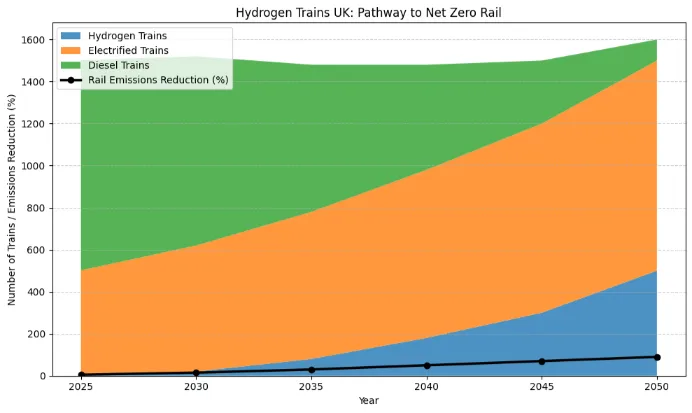
Hydrogen Trains UK: Leading the Rail Sector to Net Zero with Hydrogen Power
Hydrogen fuels in the UK are quickly changing the rail sector by offering a sustainable, zero-emission alternative to diesel-powered trains. As the UK government plans to phase out diesel trains by 2040, hydrogen-powered trains are becoming crucial for reducing carbon emissions, improving air quality, and supporting the country’s net-zero goals.
The Rise of Hydrogen Trains in the UK
Hydrogen trains use fuel cells to change hydrogen gas into electricity, producing only water vapor as a byproduct. This technology provides a clean and efficient propulsion system, which is perfect for routes that are not electrified. It allows for decarbonization without the expensive infrastructure upgrades needed for complete electrification.
The UK has made significant progress with leading projects such as:
HydroFLEX
Developed by the University of Birmingham and Porterbrook, HydroFLEX is the UK’s first hydrogen-powered passenger train. It involves attaching a hydrogen power pack to an existing Class 319 train, allowing it to run on both electrified and non-electrified routes. HydroFLEX has completed successful operational trials and uses mobile hydrogen refueling services to show practical zero-emission rail travel.
Breeze Project
Alstom and Eversholt Rail are working on the Breeze hydrogen train, which aims to create a new class of hydrogen trains for the UK rail network. The first units are expected to start running in 2024.
Scotland’s Zero Emission Train
A group that includes Transport Scotland, Angel Trains, the University of St Andrews, and Arcola Energy is converting a Scotrail Class 314 train into a hydrogen-powered vehicle as a pilot project. This will demonstrate hydrogen’s potential in the Scottish rail network.
Government and Industry Support
The UK government has made hydrogen trains a key part of its transportation decarbonization strategy. Transport ministers have stressed the importance of hydrogen trains, especially after stopping electrification on some rail routes, like the northern section of the Midland Main Line. This has increased interest in hydrogen as a viable alternative to diesel.
The Rail Industry Association (RIA) has urged the government to place fleet orders for hydrogen trains to spark investment, support jobs, and position the UK as a leader in hydrogen rail technology. The RIA points out that hydrogen trains can work alongside electrification and battery trains to achieve a fully decarbonized rail network.
For more information on government initiatives, see the UK government announcement on hydrogen transport.
Benefits of Hydrogen Trains UK
- Zero Emissions: Hydrogen trains do not produce greenhouse gases or air pollutants during operation. This greatly lowers the rail sector’s carbon footprint.
- Flexibility: Hydrogen trains can operate on non-electrified lines. This enables the decarbonization of rural and regional routes without costly electrification.
- Range and Refueling: Hydrogen trains can travel up to 600 km with refueling times similar to diesel trains. This overcomes the limitations faced by battery-only trains.
- Complementary Technology: Hydrogen fuel cells can work together with batteries and electrified rail systems. This allows for hybrid operation and higher efficiency.
Infrastructure and Refueling
Building hydrogen refueling infrastructure is crucial. Projects like HydroFLEX make use of mobile refueling trucks, while permanent refueling stations are planned to support wider usage. The UK is also increasing hydrogen production capacity, with initiatives like Project HySpeed aiming to create one gigawatt of green hydrogen production by 2030. This will ensure a sustainable hydrogen supply for transport.
Learn more about the technology behind hydrogen trains from the Institution of Gas Engineers and Managers.
Challenges and the Road Ahead
Although hydrogen trains present a lot of potential, there are still challenges:
- Cost: Hydrogen trains and their infrastructure currently require higher upfront investments than diesel or electrified trains. However, costs are expected to decline as production scales up.
- Infrastructure Rollout: Building a complete network of refueling stations is necessary for widespread adoption.
- Technology Development: Ongoing testing and demonstration projects are needed to confirm performance and safety.
The UK’s coordinated approach, which includes government financing, industry collaborations, and academic research, is tackling these challenges to enable commercial hydrogen train services in the coming years.
Conclusion
Hydrogen fuels in the UK are driving the rail sector’s shift to net zero by offering a clean, flexible, and efficient replacement for diesel trains. With successful projects like HydroFLEX and robust support from the government and industry, hydrogen trains are set to become a mainstream solution for decarbonizing UK rail networks. This supports environmental targets, economic growth, and sustainable transport for the future.
- Processes | MDPI: Article 11(9):2730 – Peer-reviewed research article from MDPI’s Processes journal.
- Hydrogen vehicles and mobility | Allianz UK – Insightful overview of hydrogen as an energy carrier and its role in mobility and transport sectors.